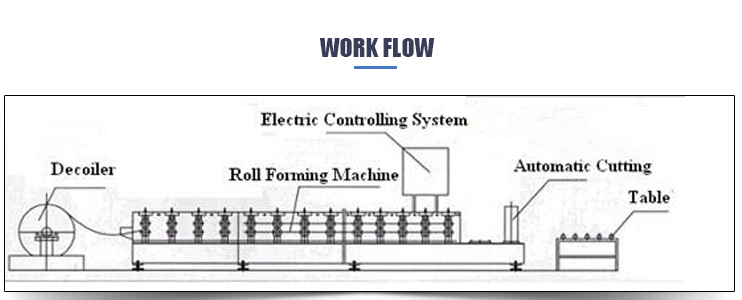C Channel Roll Forming Machine
Working principle:
Steel strip is made into C channel keel by
machine through cold-bend forming technology.
Usage:
C Channel keel produced by roll forming
machine are widely used in construction, transportation and other industries.
It is mainly used for roofing and wall of buildings, such as steel structures,
airports, storehouses,etc.
Component:
1.Decoiler
2.Roll Forming System
3.Punching system
4.Cutting Device
5.Hydraulic Station
6.PLC control system
Working Flow:
Loading coil – decoiling – guide feeding –
main roll forming – hydrarlic cutting – finished products
Technique parameters:
Processing material: aluzinc/galvanized
steel/colored steel coil
Material thickness: 0.3-2mm
Main motor power:4kw(can change as request)
Pump power: 4kw
Shaft diameter: 75mm
Forming steps: 15steps and more
Roller material: high grade 45# steel, hard
Chromium plating
Main frame: steel tube frame
Medium plate thickness: 16mm
Speed:8-12m/min
Material of the cutting blade:Cr12
Control system: PLC computer control
Power supply: 380V, 3 Phase, 60Hz (can
change as customers request)
Our C Channel Roll Forming Machine can
greatly simplifie the production process and improve production efficiency.
Customized
profile keel roll forming machine can be produced.
Welcome visit our Factory!
C Channel Roll Forming Machine C Channel Roll Forming Machine,Light Steel C Channel Roll Forming Machine,C Shape Channel Purlin Roll Forming Machine CANGZHOU DIXIN ROLL FORMING MACHINE CO., LTD , http://www.hebeimachine.com
In determining the size of the mold, consideration should be given to: dimensional changes in shell production; shrinkage of molten iron, solid state; dimensional expansion during heat treatment and the effect of scale. During the test, we adopted the concept of comprehensive shrinkage rate, namely: comprehensive shrinkage rate = liquid shrinkage, solid shrinkage, graphitization expansion, descaling, after multiple heat tests, we take the comprehensive shrinkage rate of 0.02 ~ 0.05 to determine the dimensional accuracy of the mold. Research on the technology and materials of shell casting alloy bainite ductile iron bevel gear.
The control of the surface quality of the shell surface is controlled by the finer grain size. The finer the surface, the smoother the surface, but the finer the gas permeability. After several tests, the size of the sand selected by us is 100/150 mesh. The roughness of the tooth surface of the ferrous sulfate heptahydrate completely meets the design surface requirements of the gear. The control of the resin content and the non-metallic inclusions and pores on the tooth surface are the main casting defects. The main cause of this defect is The resin content in the coated sand is too high.
The coated sand uses phenolic resin as the binder, and both phenol (C6H5OH) and formaldehyde (CH2O) contain oxygen. Under high temperature iron, the phenolic resin is decomposed, oxygen will be freed, easily oxidized, or formed by hydrogenation in the resin. Water vapor, so that the castings produce pores. In the test, we use coated sand with a resin content of 2 ~ 3, which can basically eliminate such defects. If the resin content exceeds 4, such defects will be multiplied.
